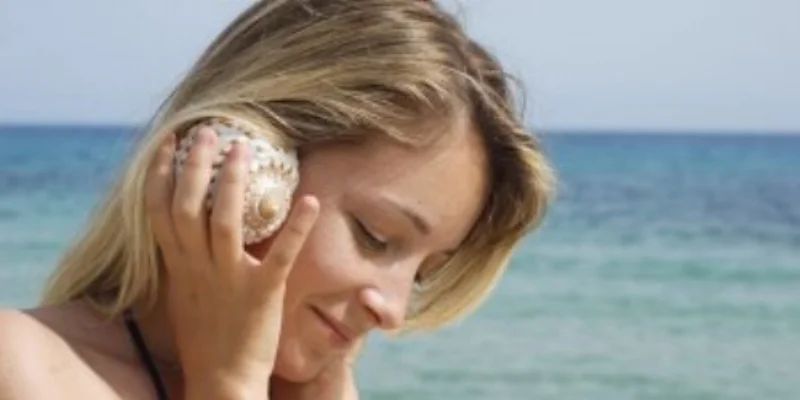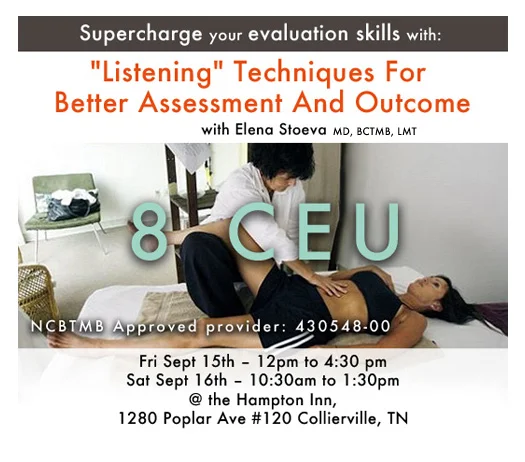L is for... Learn and Love to Listen
We are eager to add more and more new techniques to our spectrum of tools.
How much any of them is worth, if we apply it when and where it is not needed?
How do we decide what the person in our hands needs?
I'm inviting you to search for the answer in this experiential class:
"Listening" Techniques For Better Assessment & Outcome
(See the Class Highlights at the end)
September 15-16th
NCBTMB approved provider: 430548-00
The answer may start with the meaning of the word "empathy".
Definition of empathy
1: the imaginative projection of a subjective state into an object so that the object appears to be infused with it
- 2: the action of understanding, being aware of, being sensitive to, and vicariously experiencing the feelings, thoughts, and experience of another of either the past or present without having the feelings, thoughts, and experience fully communicated in an objectively explicitmanner; also: the capacity for this
Bodyworkers ( no matter from what background they come) are known to be sublime empaths. Learning to use this capacity for empathy for the benefit of our patients and for our own starts with precise assessment of their needs. Giving him/her just a little bit more or less of what is nessessary will be interpreted by the brain as STRESS. Science proved that wether the brain perceives something as either too much or not enough, it's pulled off track and not focused - a state known as "Amygdala hijack ". This is hardly a news, anymore. But what it calls for is precision - finding out what exactly the human being needs at the given moment, and deliver it. So, instead of looking for a Cookie-cutter or a protocol of techniques to "fit" our client, focus on cultivating our perceptual skills to assess the information he offers precisely.
Of course, the "listening" begins with our hands on the body. That's what we are known for. And the fun ranges from the simplicity and accessibility of palpation as a way of "listening" to the complex and tissue-specific information it offers.
Check out above the plethora of possibilities happening under our hands all the time, and simultaneously.
But we will, also, practice full body presence to"listen" and interpret correctly the abundance of information our patients offer with all our faculties- far beyond only the ear. The Japanese symbol of Kiku ("to listen", "to ask") comprised by several calligraphic parts offers deeper understanding of the meaning of "listening". It suggests that the process involves much more sensoria then only the hearing .
Learning "to listen" to the tissues is a never ending process, constantly changing, constantly evolving because the body is a very dynamic system - it changes every moment. Which makes working with it a movable fest! And yet in this process, we find comfort and inspiration, along with the wisdom of our teachers: "Only the tissues know", Rollin Becker D.O.
Jean-Pierre-Barral D.O. captured above in Visceral Manipulation 2, never fails to remind us of the infinite wisdom of the tissues.
Join me in this class to start cultivating your assessment skills and to establish your personal"style" of communicating with the human being. Because this is the subject of our work - the whole living human being. And through our work we take the responsibility to make a profound non-verbal impact on peoples' health.
"Listening" Techniques For Better Assessment & Outcome
September 15-16th
NCBTMB approved provider: 430548-00
http://www.elenasti.com/classes/classes-september-2017
Class Highlights:
- Recognize and master different levels of body and mind self- awareness
- Identify different body rhythms of expansion and contraction through palpation - cardiovascular, respiratory, cranio-sacral, lymphatic, Primo-vascular rhythms
- Discriminate between palpatory qualities of different tissues- muscles, nerves, fascia, organs( hollow and parenchymal), vessels and Primo-vessels
- Assess the feedback from them at normal versus dysfunctional state
- Learn to "listen" and trust what you hear using your whole body
- Understand how to incorporate "listening skills" in the clients' evaluation and treatment plan
- Choose the appropriate technique and dose your touch, discover presence and intention for "listening" and treating
- Practice safe entrainment with your patients
- Master movements which will make you more aware of your own and others' wellbeing
- Adapt a pace which will improve your communication with the tissues and your confidence
- The last hour of the class "Self-care Maps" in an atmosphere of peer support and interaction, is as personally healing as it is educational
This workshop includes lectures, demonstrations with patients and practice and exercises for each technique presented.
It is a great way to prepare for the future classes which will require evaluation skills to design treatment strategies.
About the instructor:
Elena Stoeva MD, BCTMB, LMT, FFIMM brings the life experience in bodywork from the perspective of : Manual Therapies and Physical Medicine in the European tradition, Cranio-sacral Therapy and Somato-emotional release, Visceral and Neural Manipulation, Lymph Drainage Therapy, BREEMA, Dance Medicine&Science, DancingForHealing approach to promoting health and treating different pathological conditions; a lifetime love and appreciation of the infinite authenticity of Bodywork as Medicine.
She can never stop learning, as the human body and her peers never stop teaching her.





